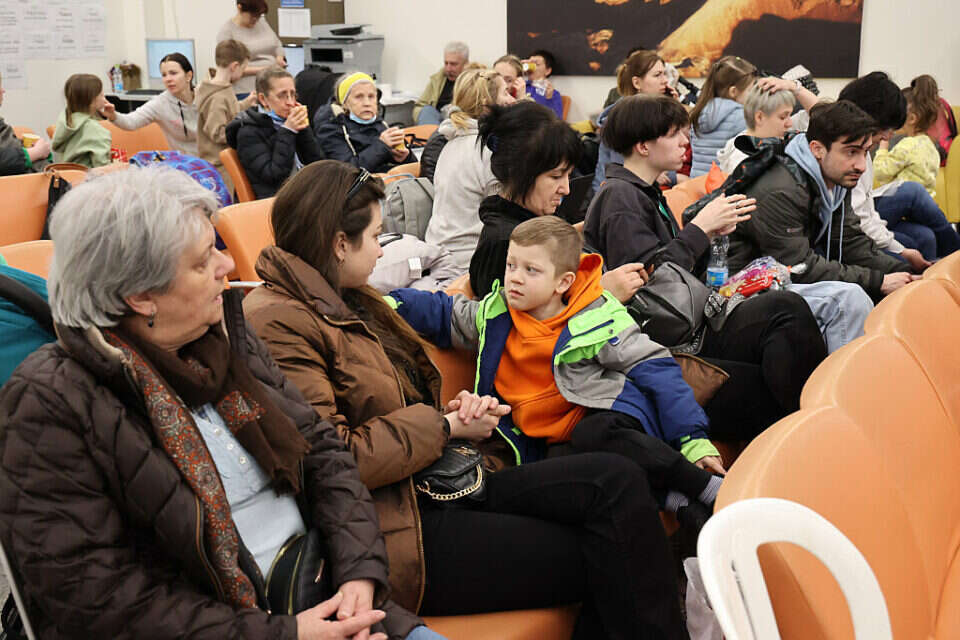In 2021, 25,497 immigrants arrived in Israel, an increase of 29.6% compared to 2020:
the largest number of immigrants came from Russia and it stands at 7,640 immigrants, 30.0% of the total number of immigrants.
This is according to the data on immigration to Israel for 2021 and immigration to Israel following the fighting in Ukraine in 2022 of the Central Bureau of Statistics and the Ministry of Immigration and Absorption.
As we published in "Israel Today" there was a jump in immigrants from Ukraine and Russia in 20222. The figures of the Ministry of Aliya reveal that between the dates 31.7.2022-24.2.2022 31,066 immigrants from Ukraine and Russia arrived in Israel.
This is a significant increase of 318% compared to the corresponding period in 2019, when 9,774 immigrants from Ukraine and Russia arrived.
Half of the immigrants from Ukraine arrived from the beginning of March to the beginning of April (about 50%).
As of the end of April, the number of immigrants from Russia was higher than the number of immigrants from Ukraine.
Most of the immigrants from Ukraine during this period were women - 63%, while men were only 37%.
On the other hand, among the immigrants from Russia, the percentage of women (50.8%) is similar to the percentage of men (49.2%).
A high percentage of immigrants came from Russia and Ukraine,
The high proportion of women among the immigrants from Ukraine is especially noticeable in the age group of 18-60, where they were close to three-quarters of the immigrants (73.9%), while the men - about a quarter (26.1%).
It seems that the explanation for the relatively small number of men aged 18-60 is the ban imposed by the Ukrainian government on the departure of men of these ages from the country's borders during the fighting.
On the other hand, among the immigrants from Russia at the same ages, there was equality in percentages between men and women (49.7% and 50.3%, respectively).
Among the immigrants from Ukraine, there was a relatively large difference between the median age of the women, which was 42 years, and the median age of the men, which was 38 years.
On the other hand, among the women and men who immigrated from Russia, the median age was similar - 35 years and 34 years, respectively.
As in recent years, in 2021 the composition of the main countries of origin will be preserved: the largest number of immigrants came from Russia (7,640 immigrants, which is 30.0% of the total number of immigrants), France (3,594 immigrants, 14.1%), the United States (3,480 immigrants, 13.6%), Ukraine (3,059 immigrants, 12.0%) and Belarus (1,014 immigrants, 4%).
About 50% came from the former Soviet Union, which as mentioned is mainly from Russia and Ukraine.
Fewer children - more workers
The immigrants are characterized by a lower percentage of children alongside a higher percentage of people of prime working age (15-64) compared to the age structure of the total population in Israel.
Comparing the age structure of the immigrants who arrived in 2021 to that of the immigrants in 2020, shows that in 2021 the share of the working-age immigrants decreased (66% compared to 70% in 2020) and at the same time the share of the older immigrants of 65 and over increased (16% compared to 13%, respectively).
The median age of the immigrants who immigrated in 2021 was 34.8 years, compared to 30 years among the general population in Israel.
As reflected in the age structure and the median age, the immigrant population is slightly older than the population in Israel.
low percentage of children,
A high percentage of academics
The immigration in 2021 was characterized by a relatively high percentage of academic occupations prior to immigrating to Israel.
Among the immigrants aged 15 and over, whose occupation abroad was known before immigrating, 61.5% had an academic occupation; 12.2% had an occupation of engineers, technicians, agents and those with a related occupation; 7.3% had an occupation of sales and service workers and 6.7% had a managerial occupation.
Among those with an academic profession, the highest percentage was of professionals in the fields of law, society and culture (40.5% of the total number of academic profession owners);
followed by science and engineering (21.8%), health (12.1%), teaching (10.1%), business and administration (9.2%) and information technology (6.2%).
As for the age distribution among the immigrants according to the last continent of residence, it appears that the immigrants who arrived in 2021 were on average about two years older than the immigrants who arrived the previous year as shown by their median age.
This is 34.8 years compared to 32.7 years, respectively.
Segmentation by last continent of residence shows that the immigrants from Europe were the oldest among the immigrants.
Their median age was 37.2 years.
They were followed by the immigrants from Asia whose median age was 31.7 years, America and Ukraine - 30.4 years.
The immigrants from Africa were the youngest, their median age was 30.0 years.
The new immigrants settled for the first time mainly in the center of the country.
Nearly half (44.7%) settled in the central districts (23.4%) and Tel Aviv (21.4%), compared to the peripheral districts, the north (10.7%) and the south (11.6%).
were we wrong
We will fix it!
If you found an error in the article, we would appreciate it if you shared it with us

